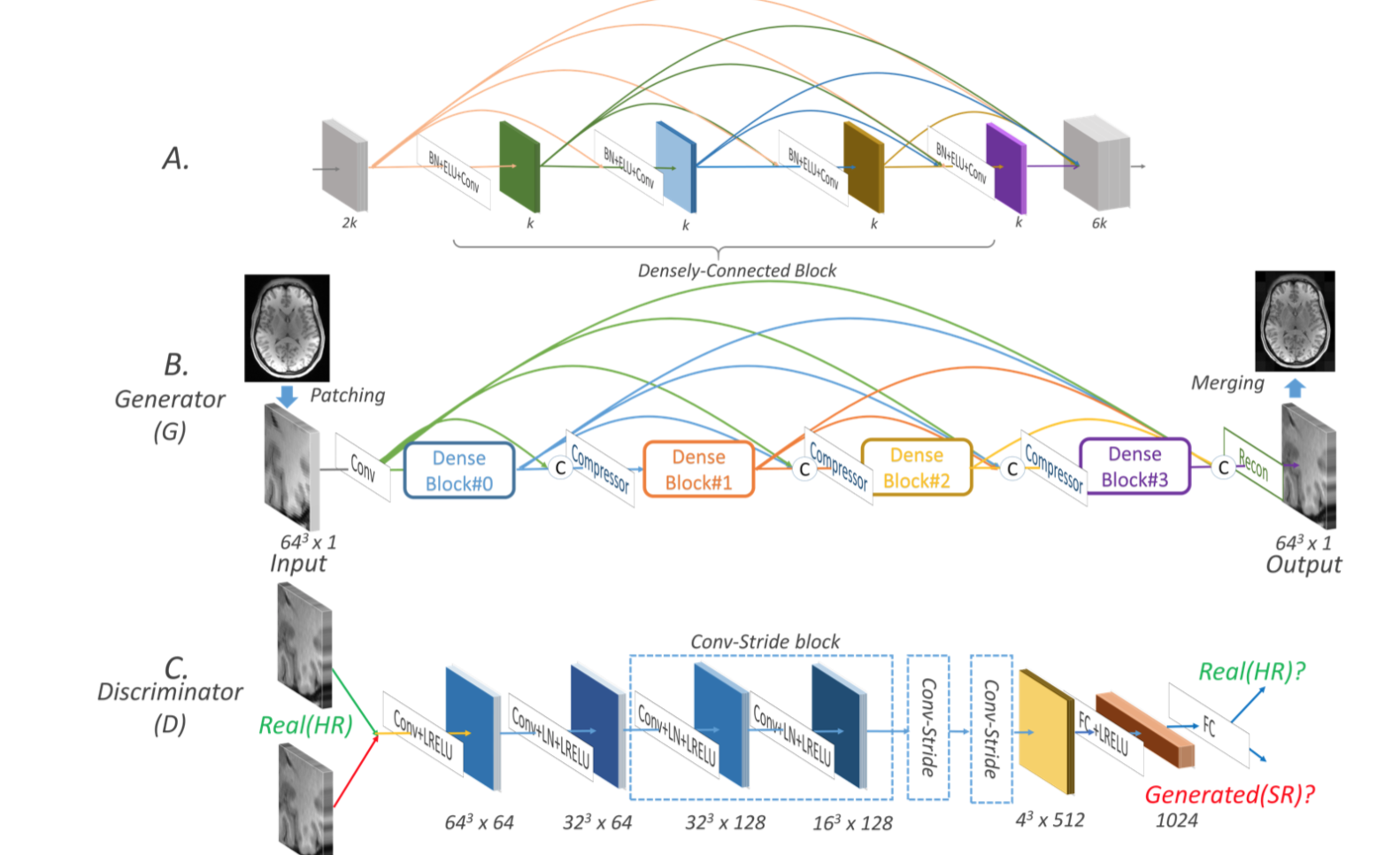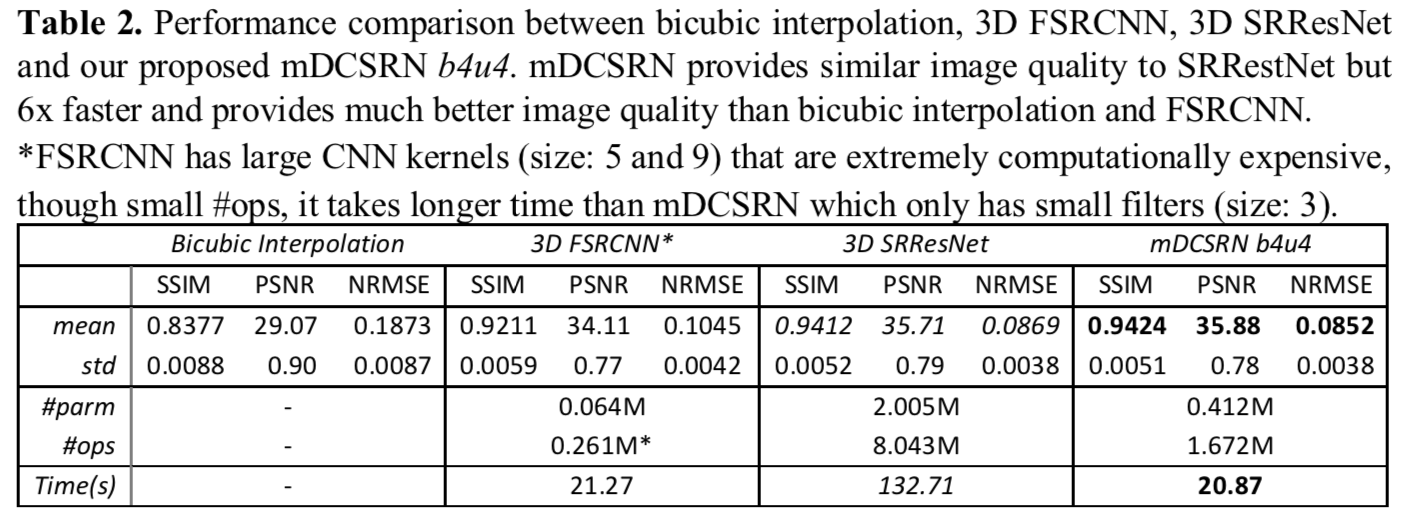はじめに
MICCAI(Medical Image Computing and Computer Assisted Intervention)2018から以下の論文のまとめ。
[1] Y. Chen, et. al."Efficient and Accurate MRI Super-Resolution using a Generative Adversarial Network and 3D Multi-Level Densely Connected Network"
著者らのgithubページはあるが
https://github.com/YuhuaBillChen/mDCSRN-MRI
コードそのものは見当たらず。
モデル名は mDCSRN (multi-level densely connected super-resolution networks)
概要
- MRI画像を超解像するモデル
- 3Dの画像を入力とし、DenseNet([2])のアーキテクチャで超解像する
- GANを用いた学習を行う
アーキテクチャ
アーキテクチャの概要図([1]のfigure 1 より)

最上部 A は3DのDense block。
本 mDCSRN モデルのgeneratorはこれをさらに densely につなげている。(B)
一方で discriminator は、ほぼほぼ SRGAN([3])と同じだが、batch normをlayer normに変えている。
コスト関数
コスト関数は1)Wasserstein-GAN([4])のgradient penaltyしたものに、2)超解像した出力画像とground truthとのL1 loss、を加えたもの。
loss = loss_{int} + loss_{GAN}
$loss_{int}$ は
\begin{eqnarray}
loss_{int} &=& loss_{L1} \ / \ LHW \\
&=& \sum^L_{z=1} \sum^H_{y=1} \sum^W_{x=1} \ | \ I^{HR}_{x,y,z} - I^{SR}_{x,y,z} | \ / \ LHW \\
\end{eqnarray}
$loss_{GAN}$ は
\begin{eqnarray}
loss_{GAN} &=& loss_{WGAN, D} \\
&=& -D_{WGAN, \theta}(I^{SR})
\end{eqnarray}
ここで $I^{SR}$ はモデルで超解像した出力。 $I^{HR}$ はground truth。
入力画像の作り方
高解像な ground truth に対応する 低解像な入力画像が必要となるが、これは[5]の手法を用いて生成する。
- FFTで高解像度画像をk-spaceに変換する
- 3次元k-spaceの周囲をゼロにすることで解像度を下げる
- FFT逆変換で画像に戻し、サイズが元に一致するよう線形に内挿する
実験の諸設定
データセット
こちら[6]から1,113データを集めた。
実験環境
- フレームワーク:tensorflow
- GPU:Nvidia GTX 1080Ti
学習の設定
- 最適化:Adam
- batch size:2
- step:500k(最初の10kはgeneratorのみでL1 lossで学習した後にdiscriminatorを加え、Dの学習7回につきGを1回学習させる。500回毎にはDのみ200回学習させる。)
比較モデル
FSRCNN、SRResNetなど。
本手法の異なる設定のモデル
- denseNetの部分のunit数やblock数を変える
- GANを用いる or 用いない
メトリクス
- SSIM(subject-wise average structural similarity index)
- PSNR(peak signal to noise ratio)
- NRMSE(normalized root mean squared error)
結果
本手法でblock数とunit数を変えた比較
本手法 mDCSRN におけるblock数とunit数を変えた場合の性能、メモリ数、実行速度は以下。

block数2でunitは4の b2u4が速度が早くパラメータ数も少ないが、性能は b4u4がいい。
他のモデルとの比較
Bicubic interpolation、3D FSRCNN、3D SRResNetとの比較は以下。

本手法が各メトリクスにおいて他の手法を上回っていて、かつ実行速度も早い。
他の手法との出力結果の比較

GANを加えるとhigh perceptualになっている。
結論
本手法 mDCSRN は(特にGAN lossを用いた mDCSRN-GANは)性能も他を上回り、かつ実行速度も上回った。
reference
[2] Huang, Gao, et al. "Densely connected convolutional networks." Proceedings of the IEEE conference on computer vision and pattern recognition. Vol. 1. No. 2. 2017.
[3] Ledig,Christian,etal."Photo-RealisticSingleImageSuper-ResolutionUsingaGenerative Adversarial Network." Proceedings of the IEEE Conference on Computer Vision and Pattern Recognition. 2017.
[4] Arjovsky, Martin, Soumith Chintala, and Léon Bottou. "Wasserstein gan." arXiv preprint arXiv:1701.07875 (2017).
[5] Chen, Yuhua, et al, "Brain MRI super resolution using 3D deep densely connected neural networks," Proceedings of 15th International Symposium on Biomedical Imaging (ISBI 2018), pp. 739-742.
[6] David C. Van Essen, Stephen M. Smith, Deanna M. Barch, Timothy E.J. Behrens, Essa Yacoub, Kamil Ugurbil, for the WU- Minn HCP Consortium. (2013). The WU-Minn Human Connectome Project: An overview. NeuroImage 80(2013):62-79.